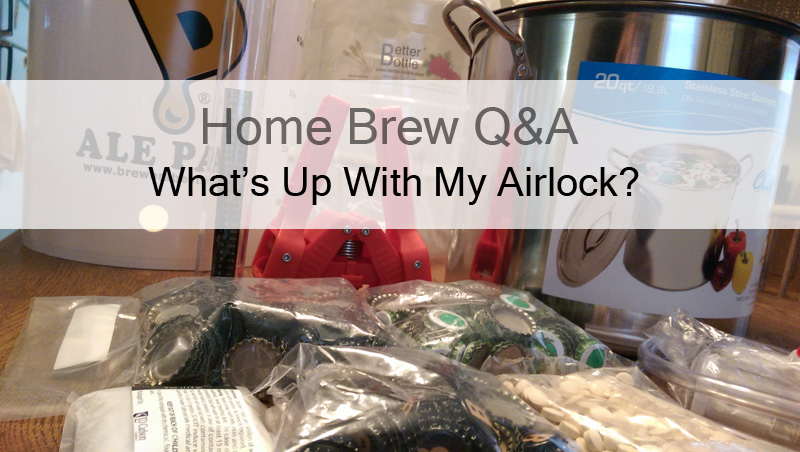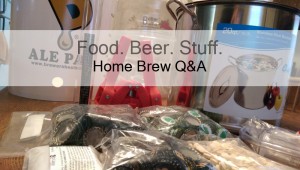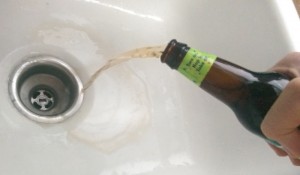
Hi Dan, I’m brewing my first beer, a German Hefeweizen. The directions say that it will ferment for two weeks before I can bottle it but today just 4 days after I put it into primary I have noticed that my airlock is no longer bubbling? Is something wrong with my beer? Why would the fermentation stop so quickly? Thanks for your help.
Thanks for your question Mark and welcome to the obsession called home brewing. As a new brewer your going to find yourself worried about quite a bit. Did I boil at a high enough temperature or long enough? Did I add too many hops or not enough? Was my sanitation sufficient? These questions and many others will run through your head making you worry that there is a chance your beer is ruined.
With all these things to worry about as a new brewer, I’m happy to inform you that one thing you don’t have to worry about is airlock activity.
Watching an airlock happily bubble away can fill the home brewer with excitement and anticipation. I admit that even after over 10 years of brewing at home I still look to my airlock as well, but I shouldn’t. While it is true that bubbling airlocks can be a sign of active fermentation, the lack of airlock bubbles does not mean fermentation has ceased or never started and the presence of airlock bubbling does not mean that everything is OK.
The airlocks function is to sit on the top of your fermentation vessel and provide a means of relieving built up pressure while not allowing air from outside the fermentation vessel in. The airlock only bubbles when the pressure has built up to a level great enough to force the air out. This pressure from the gas will take the easiest route of escape. In a perfect world, that would be through the airlock but we all know the world is far from perfect.
Lack of airlock bubbles can mean that the air has found an easier place to get out. This could point to an imperfect seal creating an air leak from a loose lid or bung or faulty grommet. Bubbles slowing down or stopping entirely most likely just means that the fermentation has slowed down a bit after its initial vigorous start, this is completely normal. It stands to reason that as the fermentation slows down, pressure will decrease and airlock bubbling will cease.
As the yeast eat the fermentable sugars, they expel CO2. As CO2 is a heavier gas than Oxygen, it forms a protective layer on top of your wort shielding it from oxygenation, which can ruin the taste of your beer. So with that in mind, it is good to remember that when everything is going right, some gas will stay inside the fermentation vessel.
Just as lack of airlock activity does not point to lack of fermentation, an active airlock does not mean proper fermentation has occurred. Yeast is not the only thing that might be chowing down on the sugars in your wort. Without proper sanitation, bacteria could be actively spoiling your beer and expelling quite a bit of gas in the process making your airlock bubble like crazy. This is highly unlikely with even the most basic of sanitation measures but it does go to show one that going by airlock activity to keep track of a beers fermentation can be very unreliable and problematic.
What has most likely occurred in your brew is that you went through a nice stage of very active fermentation and your wort is approaching its final fermented state. The directions mention two weeks but that does not mean that the fermentation will remain at the same level for two weeks. It is normal and expected that after some given amount of time that things simply start to slow down.
I have had beers that have bubbled the airlock non-stop for a week and some that never produced bubbles at all and everything in between . The one commonality between them all is that I eventually had a drinkable beer that came out just fine. It is easy to obsess over each detail as a new brewer (heck even as an old one) but one thing that I always remind myself is that beer was discovered by accident and has been made for thousands of years without airlocks, proper sanitation and other modern technologies we are fortunate enough to employ today. It is a natural process that wants to occur, despite our tendency as humans to blunder. This thought always gives me great relief when I start to worry I did something wrong.
So if airlocks are the wrong way to measure fermentation what is the right way?
The only reliable way to judge the level of fermentation is with the use of a hydrometer. If you haven’t already, I would purchase a hydrometer and get in the habit of using it.
A hydrometer works on an ancient force of nature discovered by Archimedes which, simply put, is that any object placed into water will displace its weight in water. A hydrometer is calibrated so that when its weight is submerged in pure water the displaced water will buoy it up and the reading will be at 1000. When we dissolve solids into water, as is the case when we make wort, the waters weight increases making the hydrometer sink lower. As the sugars get processed by the yeast, the wort’s weight decreases making the hydrometer rise.
To properly gauge your beers stage of fermentation it is best to get a hydrometer reading shortly after pitching your yeast. This reading is called your Original Gravity or OG. As the beer ferments the hydrometer will rise giving different readings, these measurements can be referred to as the beers Specific Gravity or SG. After some time, the hydrometer will stop rising and the measurement will be the same over a number of days, this reading is referred to as the Final Gravity or FG. When this happens it means that your wort has turned into beer and the yeast have eaten all the fermentable sugars that they were capable of.
Since this is your first brew, I’m willing to assume that you used a recipe kit, as such your kits instructions should give the estimated OG and FG. It may be too late to get your actual OG reading but you can still monitor your brews SG and wait for it to reach the kits estimated FG.
One more thing, since I have your ear for the moment. The instructions say to wait for two weeks but most people find that to be the bare minimum amount of time to leave your beer in primary. I usually leave it alone for at least 3 weeks and commonly 4 weeks before I even worry about checking my SG. Though FG can be reached in as little as a few days, the yeast are still active, cleaning up after their feast as they enter new stages of their life cycle. You will find that leaving your beer alone an extra week or two will improve the beers taste and clean up any off flavors the yeast may have produced.
I know it can be hard to wait that long for your first home brewed beer but your reward will be worth the patience.
I hope you now have a greater understanding of airlock activity and how it relates to your beers stage of fermentation. If you have any further related questions please feel free to ask in the comments below. Best of luck to you and happy brewing!








When using a secondary carboy, what is a safe amount of time to leave in the primary? Day 7, gravity reading has stayed for 2 days. Stout.
Hey, whats up mason? Thanks for the question.
If your going to rack to a secondary the main thing to keep in mind is to allow the primary fermentation to complete. It sounds like your there so thats good on that part.
The second thought is that one will want to let the yeast have enough time to clean up acetaldehyde and diacetyl which is created during the initial fermentation before the transfer. This is known as the conditioning phase.
If your at day 7 and you have hit your fg, i would think another week would give the yeast the time they need to clean up those off flavors.
Though plenty of yeast remains in suspension, if you transfer too soon there may not be enough yeast present afterwards to make a quick job of it, forcing a longer aging process after bottling to get the right flavor.
I would normally not recommend transferring to a secondary period, unless additional sugars will be added (like fruit or what not) for an actual second fermentation or for long term aging, souring, etc…
If your stout is standard and your not doing some of the above, i’d consider just leaving it in the primary and letting the yeast do their thing though. Why is it you plan to rack to secondary?
Hope that all made sense, I’m a few beers deep at the moment 🙂 let me know if I can clear anything up or if you have more questions.
Made perfect sense. I am however introducing 4oz of american oak chips soaked in bourbon (been soaking for 7 days), the reason for the secondary. Probably still best to let it remain for another week. Thanks for input.
mmmm. That sounds awesome. Love me a wood aged stout. Sounds like you got the right idea. Let me know how it turns out.
Thanks for this page…. It was a great read.
Great info nz man
Thanks for the clear and very helpful information .. put my mind at ease as I was having the same concerns about the airlock bubbling
Thanks Julie. Hope it all worked out well
Thanks for above information.. I came here wid same question.
Hi I’m wondering why my bubbles have stoped after 4days and the hydrometer is reading 1010, is my brew ok? It looks like it’s dead?
Hi Steve, it is kinda hard to say with any certainty. I would guess that it hasn’t actually stopped fermenting, it simply is no longer observable through the airlock, this is normal. If your initial fermentation was vigorous I wouldn’t worry about it. Keep an eye on the Specific gravity. What was your original gravity? What is your estimated Final gravity? If it has changed then I’d feel ok about it.Just keep an eye on it. You can always pitch some more yeast if it stalls but I wouldn’t do that until you are sure that is the case after a few days.